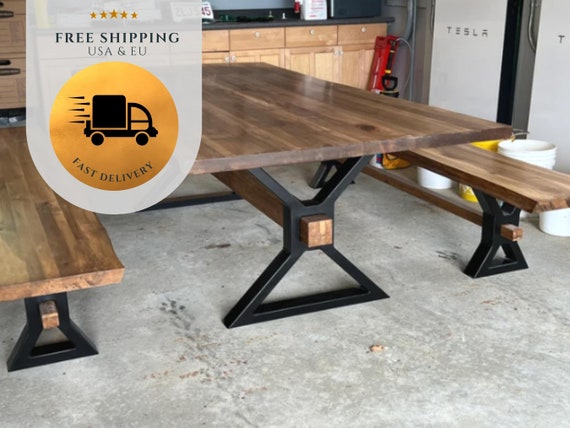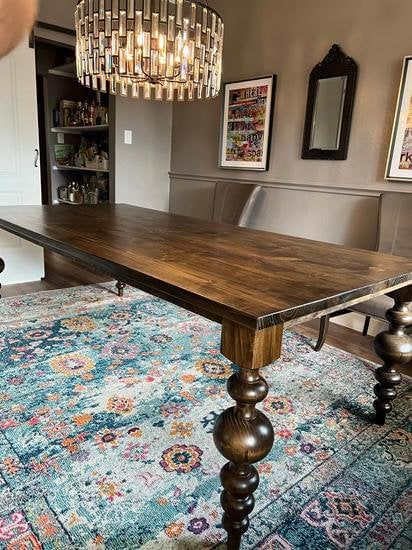Expert Tips for Installing Dining-room Table Legs for Optimum Stability
When it comes to mounting dining space table legs, attaining maximum stability is paramount for both performance and aesthetic appeals. What specific strategies can boost security also further?
Pick the Right Legs
When choosing the ideal legs for your dining space table, it is necessary to take into consideration both functionality and aesthetics. The legs you choose will dramatically impact the general layout and security of the table. Initially, review the table's intended use; if you expect frequent events, stronger legs, such as those made from solid timber or steel, might be more appropriate, as they provide raised sturdiness and assistance.
Next, take into consideration the elevation and style of the legs in connection with the table top. Conventional dining tables generally range from 28 to 30 inches in height, so guarantee the legs align with this criterion for comfort. The style of the legs must complement the design of the tabletop-- whether it be contemporary, rustic, or conventional. For instance, tapered legs can include a modern touch, while turned legs may communicate a much more timeless visual.

Select Appropriate Hardware
Exactly how can the right equipment boost the stability and durability of your eating room table? The choice of proper equipment is essential to guaranteeing that the legs of your table are firmly connected and able to stand up to normal usage. Premium screws, screws, and brackets give the needed toughness to support the weight of the table, along with any extra loads placed upon it during meals or events.
When choosing screws, choose those made from long lasting materials such as stainless steel or brass, which resist rust and preserve integrity over time. The length of the screws is similarly essential; they ought to permeate deeply right into the table's framework without endangering integrity. For bolted connections, consider using lock washers to avoid loosening up due to vibration or movement.
Furthermore, utilizing edge brackets can include additional support, especially for bigger tables or those with much heavier tops. These brackets distribute weight equally and assist maintain the table's form. Making sure that the hardware you pick is ideal for the certain materials of your table will better improve its general stability and long life, enabling you to appreciate your dining experience for years to come.
Ensure Proper Placement
Proper alignment of eating room table legs is crucial for both aesthetic allure and functional security. To attain optimal alignment, begin by gauging the distance from the table's corners to the leg accessory factors.
Make use of a level during setup to validate that each leg is vertical to the table top. It is recommended to note the wanted leg positions on the underside of the table with a pencil or masking tape before safeguarding them.
Furthermore, double-check the alignment after the first screws are tightened, as modifications might be essential prior to totally these details safeguarding the hardware. By prioritizing proper placement, you not just boost the table's general style yet additionally make certain that it continues to be secure and functional for several years ahead.

Think About Weight Distribution
After ensuring correct positioning of the dining-room table legs, it is necessary to think about weight circulation to boost stability and functionality. dining room table legs. Proper weight circulation is important in avoiding tottering and making sure that the table can sustain its designated lots without danger of tipping or collapsing
When placing the legs, guarantee they are placed at equivalent distances from the center of the table to uniformly distribute the weight across the structure. Take into consideration the weight of the tabletop and any kind of items check out here that will often hinge on it, such as decorative items or tabletop home appliances. Tables with much heavier surface areas ought to preferably have legs positioned closer to the edges, as this optimizes the base of support and lessens the threat of instability.
Additionally, if the table is meant for use in a high-traffic location, consider making use of much heavier products for the legs or including supporting aspects, such as cross-bracing or a reduced shelf - dining room table legs. These modifications can assist keep balance and avoid changing throughout usage. Eventually, a well-considered weight circulation strategy will substantially boost the table's total performance, ensuring it stays a attractive and functional centerpiece for your eating space
Test Stability Before Use
Testing the stability of the eating area table prior to usage is a critical action that should not be neglected. If the table shows instability, identify the legs or joints that may call for adjustment.
Following, examine that all fasteners and screws are tightened correctly. Loosened connections can lead to instability and possible damages over time. If necessary, make use of wood adhesive on joints to improve security, making certain to enable sufficient drying out time.

Verdict
To conclude, the setup of eating space table legs needs mindful consideration of products, weight, hardware, and alignment distribution to accomplish optimum security. By selecting high-grade bolts and strong legs, making sure specific placement, and distributing weight evenly, the structural stability of the table can be dramatically boosted. Conducting a security test prior to normal use better makes certain that the table will certainly endure day-to-day pressures, consequently offering a safe and trustworthy dining experience.
When it comes to mounting eating space table legs, attaining optimum stability is vital for both functionality and looks. The legs you choose will significantly affect the general style and security of the table (dining room table legs). Basic dining tables normally vary dining room table legs from 28 to 30 inches in height, so make sure the legs align with this requirement for comfort.Appropriate alignment of dining room table legs is important for both aesthetic appeal and functional stability.In conclusion, the installment of dining area table legs calls for cautious consideration of products, alignment, weight, and equipment distribution to achieve optimum security
Comments on “The Top Trends in Dining Room Table Legs You Need to Know”